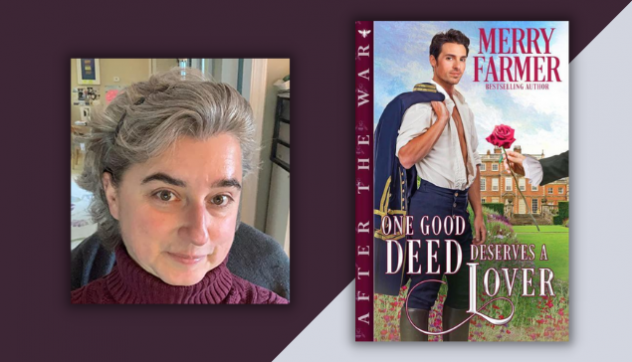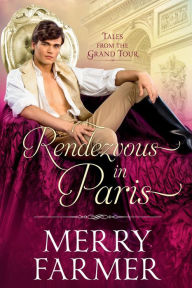I would be willing to bet that everything you think you know about queer romance throughout history is wrong. Actually, I would be willing to bet that you were never taught queer history to begin with. And, especially not in school. I wasn’t taught in school either. But from the moment I discovered that Frederick the Great of Prussia was not only one of the most brilliant and forward-thinking rulers ever, and that he was known to be gay, I started to wonder about these things. The answer to why we were never taught queer history is pretty obvious. So, why did I choose to start writing in an emerging and thriving sub-genre of Historical Romance about a part of History that “never existed”?
A Guest Post by Merry Farmer
I write M/M Romance because love has always been love. No matter what a small handful of historians writing in the mid-20th century might have wanted people to believe. What’s this? Historians are biased in the way they interpret and report History? They’ve swept a bunch of details under the carpet to advance a particular narrative that denigrates an entire demographic? No! Say it ain’t so!
Historians have always been biased. One of the best courses I took while earning my degree in History was Historiography. This is the study of how history has been recorded and interpreted and the biases historians have had. It’s fascinating—and a bit horrifying—to see how certain parts of our history have been emphasized and others have been swept under the carpet. And from the moment it dawned on me that the history of women, non-white people, and queer people has always been as rich and expansive as the things someone decided to put in my high school history books, I’ve sought out the parts of history that have been previously hidden.
And let me tell you, there is so, so much queer history that is only just being uncovered now! The notion that, prior to the Stonewall Riots of 1969, ALL gay men were closeted, ashamed of themselves, isolated, and that they would be instantly put to death if they came out is a deliberate distortion, sold to the public by people with an agenda. The truth is that homosexuality in all its forms has been much more widely accepted throughout history than most of us were taught. Actual, academic historians like Peter Ackroyd, Matt Cook, Graham Robb, and George Chauncey have published multiple, deeply researched works debunking the biased view of History that too many people take as gospel truth.
The truth about queer life in the 19th century, the era I write about, is that the subculture of both men and women who lived perfectly happy and productive lives bucking the system was extensive and it was thriving. There were countless cases of “confirmed bachelors” cohabiting, or women friends who were deeply devoted to each other and wrote about as much in their diaries and letters.
Even prior to the Industrial Era, there are multiple instances of male couples being buried together under tombstones that bear all of the markings of married couples—from Crusaders buried in the Holy Land to scholars in the 1700s. Artists and authors throughout history have known this and depicted it in their art. And if I had time, I would absolutely bring up the fact that a form of gay marriage was sanctioned by both the church and the state through most of the Middle Ages, but that’s a can of worms for another day!
But wait, you say. We can’t judge relationships of people in history through the lens of a modern perspective. YOU’RE RIGHT. We can’t. And guess what? The entire concept of identifying as homosexual and the aggressive male machismo that too many 21st century people believe is the masculine norm are modern inventions. The term “homosexual” wasn’t even coined until the 1870s, and it didn’t appear in English until the 1890s. Prior to that, the sexual act was a verb—something men (and women) did, and who they did it with filled an entire spectrum of behavior, none of which would end up with someone being labeled as gay. There is a wealth of primary-source material spanning centuries that suggests attitudes toward same-sex relations were relatively open compared to what those 20th century historians wanted us to believe.
Ah ha, you also say! But sodomy was illegal and punishable by death in England and other places until well into the 19th century! It’s true. Henry VIII passed the Statute of 1533, making sodomy punishable by death. But the timing of that statue is important. Don’t forget, good old Henry was in the middle of the dissolution of Catholic monasteries at the time. The 1533 statue was a convenient way to kill Catholic priests and to take their land. In fact, as Peter Ackroyd discusses in his book Queer City, the anti-sodomy laws in England, while certainly present and dire, were the least enforced laws that have ever been passed.
The same holds true for the latter part of the 19th and early 20th centuries. We think of men like Oscar Wilde and Alan Turning as examples of how gay men were treated. In fact, statistically, they were exceptions to the rules rather than the standard. In the same London where Oscar Wilde was being sentenced for gross indecency, hotels like The Savoy and The Albermarle, along with many others, were so gay-friendly that they even had sections of their restaurants reserved for gay men. Author George Ives even wrote about incidents where Oscar Wilde kissed him passionately in the restaurant of the Savoy Hotel without anyone batting an eyelash or making any sort of comment. George Ives wrote extensively and publicly about the rights of gay men, and he was instrumental in forming the first gay rights organization in Britain, the Order of Chaeronea…in 1897.
Which brings us back to my excitement about writing Queer Historical Romance. Especially now, in a time when academic researchers are working hard to overturn a century’s worth of biased historical interpretation. The love stories I write are not only plausible, they are almost certainly reflections of what was actually going on. The evidence that love has always been love and life was lived out of the closet is very much there. And when the story that the vast majority of the population takes for granted as true is, in fact, horribly, horribly false, I consider it my mission to change the minds of people who have false narratives so deeply ingrained in their consciousnesses that they balk at the idea of the truth on a visceral level (as you might have done reading this article) by writing M/M Historical Romance.
I’m hoping to change hearts and minds about queer romance throughout history one love story at a time.
About Merry Farmer
Merry Farmer is an award-winning novelist who lives in suburban Philadelphia with her two cats, Butterfly and Torpedo. She has been writing since she was ten years old. Merry realized one day that she didn’t have to wait for the teacher to assign a creative writing project to write something. It was the best day of her life. She then went on to earn not one but two degrees in History so that she would always having something to write about. Today she is a giant History nerd and a hopeless romantic waiting for her own love story to start.
Contact Merry Farmer
- Website: https://www.merryfarmer.net/
- Facebook: https://www.facebook.com/merryfarmerauthor/
- Instagram: https://www.instagram.com/merryfarmer/













